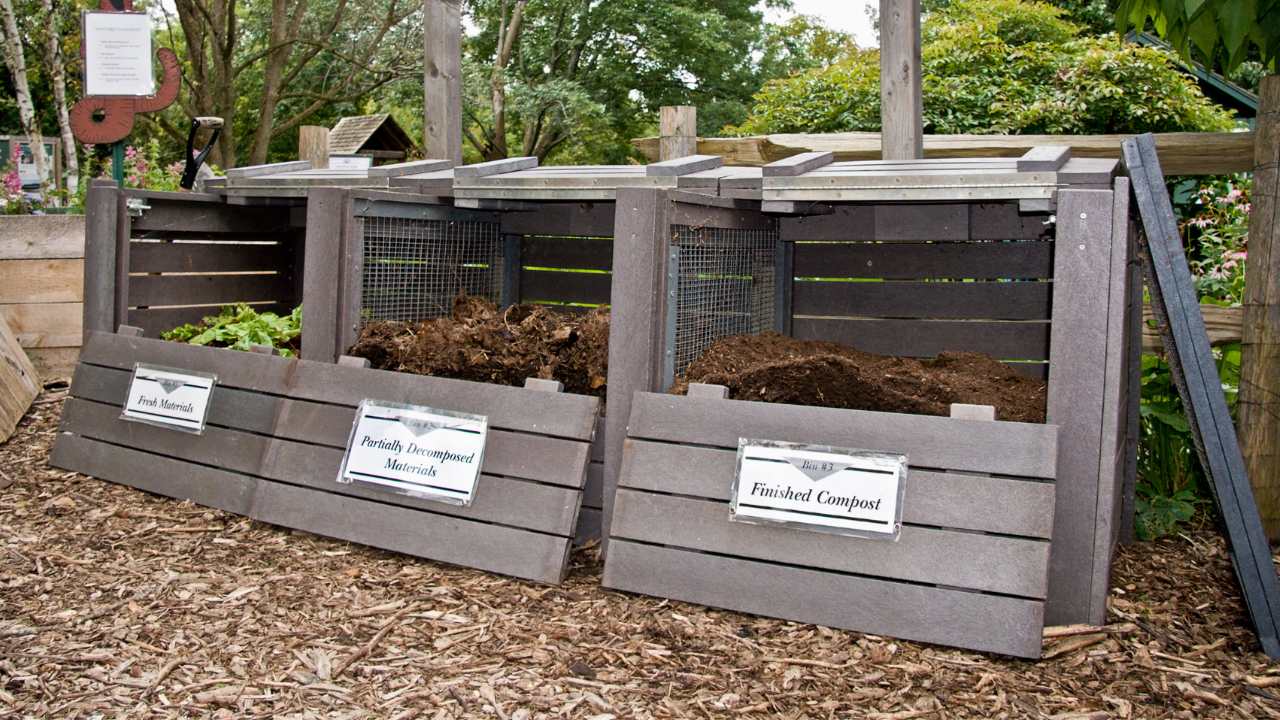How Do You Use a Compost Bin for Beginners?
To use a compost bin for beginners, layer food scraps, yard waste, and soil in it regularly. Turn the compost weekly for proper aeration and decomposition.
Composting is a sustainable practice that transforms organic waste into nutrient-rich soil.
By following simple steps and maintaining the balance of green and brown materials in your compost bin, you can create a valuable resource for your garden.
Beginners can easily get started by understanding the basics of composting and actively participating in the process.
With time and care, you will enjoy the benefits of reduced waste and healthier, more vibrant plants in your garden.
Get ready to embark on your composting journey and contribute to a greener environment.
Choosing The Right Compost Bin
Consider Your Space
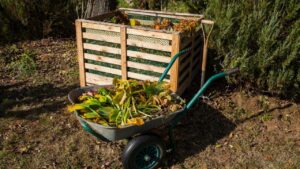
Before deciding on a compost bin, it’s essential to consider the available space you have for composting.
Evaluate whether you have a large garden or just a small balcony.
Think about where you plan to place the bin and ensure that it fits within the designated area.
Consider the aesthetic appeal as well, choosing a compost bin that will blend well with your outdoor space.
Different Types Of Compost Bins
There are various types of compost bins available, each with its own benefits and considerations. Some of the most common types include:
- Tumbler Compost Bins
- Wire Mesh Compost Bins
- Free-Standing Plastic Compost Bins
- Vermicomposting Bins
Setting Up Your Compost Bin
When it comes to setting up your compost bin, there are a few key steps that beginners should follow.
Starting with finding a suitable location, preparing the base, and layering your compost are essential for successful composting.
Let’s delve into each of these steps in detail:
Find A Suitable Location
• Look for a shady spot with good drainage
• Ensure the area is easily accessible for adding materials and turning the compost
• Avoid placing the compost bin directly on a hard surface
Prepare The Base
• Lay down a thick layer of browns, such as dry leaves or shredded paper
• This will help with air circulation and improve the composting process
Layering Your Compost
• Alternate between green and brown materials for a balanced compost mix
• Add kitchen scraps, grass clippings, and other organic waste
• Ensure each layer is moist but not soggy to promote decomposition
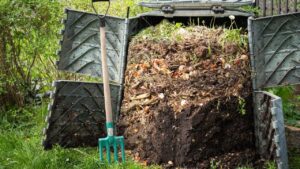
What To Compost
Learn how to effectively use a compost bin as a beginner by understanding what compostable materials you can add to it.
Discover the key ingredients for successful composting and start transforming your kitchen and garden waste into nutrient-rich soil.
Green Materials
- Fruit and vegetable scraps
- Coffee grounds
Brown Materials
- Dry leaves
- Newspaper
Avoid These Items
- Dairy products
- Meat or fish scraps
Composting is a simple and eco-friendly way to reduce waste.
Ensuring you compost the right materials is crucial for the process to be effective.
Green materials such as fruit and vegetable scraps and coffee grounds add nitrogen to the compost, aiding in decomposition.
Brown materials like dry leaves and newspaper provide carbon, balancing the compost mixture.
Avoid composting dairy products, meat, or fish scraps as they can attract pests and slow down the composting process.
Maintaining Your Compost Bin
When it comes to maintaining your compost bin, there are a few key factors to keep in mind to ensure that your waste is properly converting into nutrient-rich organic matter.
By actively managing your compost, you can speed up the decomposition process and maintain a healthy environment for beneficial microbes to thrive, producing high-quality compost for your garden or plants.
Turning Your Compost
To keep the decomposition process efficient and prevent unpleasant odors, you should turn your compost regularly.
This aerates the pile, allowing oxygen to penetrate and support the breaking down of organic matter.
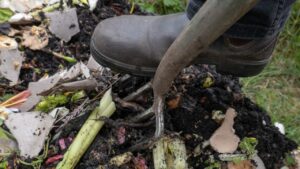
Use a pitchfork or a compost aerator to gently mix the contents, ensuring that the outer material is moved to the center and vice versa.
Keeping It Moist
Maintaining the right level of moisture is crucial for successful composting.
Your compost should feel like a damp sponge but not be waterlogged.
Check the moisture level by grabbing a handful of compost and squeezing it.
If a few drops of water come out, it is adequately moist.
If it’s too dry, consider watering it with a watering can or adding more green materials.
If it’s too wet, mix in some dry materials like leaves or shredded paper to absorb the excess moisture.
Managing Temperature
It’s essential to monitor the temperature within your compost bin, as beneficial microorganisms thrive in specific temperature ranges.
The ideal temperature for composting ranges between 135°F and 160°F.
You can use a compost thermometer to check the internal temperature of the pile.
If it’s too hot, turn the compost more frequently to cool it down.
If it’s too cold, add more green materials to increase the heat-generating decomposition process.
Harvesting And Using Compost
To effectively use a compost bin as a beginner, start harvesting compost once it appears dark and crumbly.
Utilize it in your garden by mixing it with soil for enriching your plants with essential nutrients.
Be mindful of the composting process to enhance your garden’s health and sustainability.

Knowing When It’s Ready
One of the most important aspects of using a compost bin is knowing when your compost is ready to be harvested and used.
Compost is ready when it has turned into a dark, crumbly material that smells earthy and has a rich texture.
The process can take anywhere from a few weeks to several months, depending on the conditions in your compost bin.
To determine if your compost is ready, look for these signs:
- The temperature of the compost has cooled down significantly.
- The compost no longer has a strong odor, but smells like fresh soil.
- The original materials used in the compost bin are no longer recognizable.
- The texture of the compost is crumbly and easy to handle.
Once you’ve determined that your compost is ready, you can start using it in your garden or for other purposes.
Using Your Compost
Using your compost is a simple and effective way to nourish your plants and improve the health of your garden.
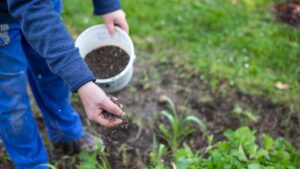
There are several ways you can use your compost:
- Mix it in with the soil when planting new plants or vegetables.
- Spread a layer of compost around existing plants to provide them with nutrients.
- Create a compost tea by steeping compost in water and using it as a liquid fertilizer.
- Use the compost as a top dressing for your lawn to improve soil health.
Remember to dig the compost into the soil or cover it with a layer of mulch to help retain moisture and prevent weed growth.
Storing Unused Compost
If you find that you have more compost than you need at the moment, you can store it for later use.
It’s essential to store compost properly to maintain its quality.
Here are some tips for storing unused compost:
- Transfer the compost to a sturdy container with a lid, such as a plastic bin or a compost bag.
- Keep the container in a cool, dry place to prevent moisture buildup and potential odor.
- Avoid storing your compost in direct sunlight, as it can dry out and lose its beneficial microorganisms.
- Check on the compost occasionally to ensure it remains in good condition.
- When you’re ready to use the stored compost, mix it with fresh compost or garden soil to reactivate any dormant microorganisms.
By following these tips, you can keep your unused compost fresh and ready for use whenever you need it.
Frequently Asked Questions Of How Do You Use A Compost Bin For Beginners?
How Do You Choose A Compost Bin For Beginners?
To choose a compost bin, consider factors like size, material, ventilation, and ease of use.
Can You Compost Fruit And Vegetable Scraps In A Compost Bin?
Yes, fruit and vegetable scraps can be composted in a compost bin, providing valuable nutrients for your garden.
How Often Should You Turn A Compost Bin For Beginners?
For beginners, turning the compost bin once every two weeks is recommended to promote decomposition and prevent odors.
Do You Need To Add Water To A Compost Bin?
Yes, it is important to add water to a compost bin to maintain the right moisture level for decomposition.
What Can You Not Put In A Compost Bin For Beginners?
Avoid putting meat, dairy products, oily foods, and pet waste in a compost bin to prevent pests and unpleasant odors.
How Long Does It Take For Compost To Be Ready In A Compost Bin?
Compost can take anywhere from a few months to a year to be ready, depending on factors like temperature, ingredients, and turning frequency.
Can You Compost Grass Clippings In A Compost Bin?
Yes, grass clippings can be composted in a compost bin, but they should be mixed with other materials to prevent clumping.
Can You Compost Leaves In A Compost Bin?
Yes, leaves are great for composting as they add carbon and help create a balanced compost mixture.
How Do You Use Compost In Your Garden As A Beginner?
As a beginner, mix compost into your garden soil, use it as a top dressing, or create a compost tea to fertilize plants.
Can You Compost Weeds In A Compost Bin For Beginners?
Yes, you can compost weeds in a compost bin, but make sure they don’t have seeds or rhizomes to prevent them from spreading.
Conclusion
Using a compost bin as a beginner is a simple and rewarding process.
By following the right steps, you can help reduce waste and improve soil health.
With proper maintenance and care, you can create nutrient-rich compost for your garden.
Embrace the sustainability and benefits of composting today.

